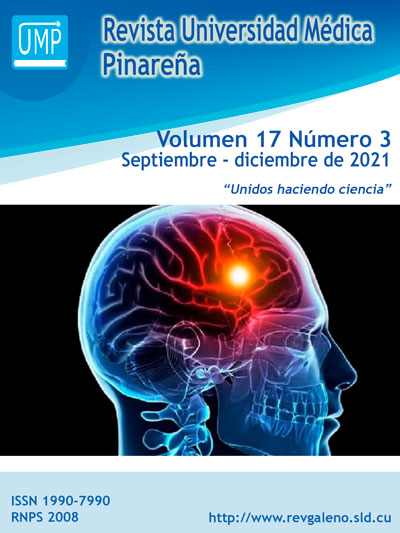Collection of cerebrospinal fluid in subdural space after aneurysmal subarachnoid hemorrhage
Keywords:
Cerebrospinal Fluid, Subdural Space, Subarachnoid Hemorrhage, Intracranial Aneurysm, Aneurysm, RupturedAbstract
Introduction: subarachnoid hemorrhage, a cerebrovascular disease, is usually caused by aneurysms and is associated with significant impact on morbidity and mortality of affected patients. One of the complications derived from this disease are cerebrospinal fluid collections in the subdural space.
Case report: a 68-year-old black female patient, inveterate smoker and hypertensive, who was admitted to the center after suffering sudden headache with loss of consciousness and fall to the floor without cranioencephalic trauma, the physical examination revealed manifestations of drowsiness, psychomotor agitation, disorientation in time, space, person and miotic pupils, some signs and symptoms indicative of endocranial hypertension. In the initial imaging study by simple computed axial tomography of the skull, the subarachnoid and subdural spaces were not expanded and a diffuse bleeding pattern corresponding to a subarachnoid hemorrhage was observed, corresponding to a Fisher 4 subarachnoid hemorrhage. After 24 hours of evolution, due to the worsening of the neurological symptoms (nuchal rigidity, non-reactive pupils, right anisocoria and Glasgow 7), an evolution computed axial tomography was performed, which showed a decrease in the width of the III ventricle, interstitial edema, midline displacement and accumulation of cerebrospinal fluid in the fronto parietotemporal-subdural space.
Conclusions: the diagnosis of external hydrocephalus was established, a rare condition that compromises the recovery and survival of the patient. It is important to differentiate this type of hydrocephalus from other subdural cerebrospinal fluid collections.
Downloads
References
2. Sociedad Española de Neurología. Consejo General de Colegios Oficiales de Farmacéuticos. Guía práctica ictus. Madrid [Internet]. 2017 [citado 15/01/2020]. Disponible en: http://www.portalfarma.com/guia-prevencion-ictus/.
3. Loch-Macdonald R, Schweizer TA. Spontaneous subarachnoid haemorrhage. The Lancet [Internet]. 2017 Jun [citado 15/01/2020]. Disponible en: https://www.intramed.net/contenidover.asp?contenidoid=90449
4. Rivero-Rodríguez D, Scherle-Matamoros C, Fernández-Cúe L, Miranda-Hernández JL, Pernas-Sánchez Y, Pérez-Nellar J. Factores asociados a una evolución desfavorable en la hemorragia subaracnoidea aneurismática. Serie de 334 pacientes. Sociedad Española de Neurología [Internet]. 2017 [citado 15/01/2020]; 32(1):15-21. Disponible en: http://dx.doi.org/10.1016/j.nrl.2014.12.006.
5. García-Intriago GG. Correlación entre accidente cerebrovascular hemorrágico e hidrocefalia. Tesis para optar por el título de Médico. Universidad de Guayaquil [Internet]. 2018 [citado 15/01/2020]. Disponible en: http://repositorio.ug.edu.ec/bitstream/redug/36259/1/CD%202747%20GARC%c3%8dA%20INTRIAGO%20GREGORIO%20GABRIEL.pdf.
6. Preguntegui-Loayza IF. Factores demográficos y clínicos asociados a hidrocefalia shunt dependiente en hemorragia subaracnoidea aneurismática. Hospital Nacional Alberto Sabogal Sologuren 2014-2018. Tesis para optar por el título de segunda especialidad en Neurocirugía [Internet]. 2019 [citado 15/01/2020]. Disponible en: http://200.37.171.68/bitstream/handle/usmp/5015/preguntegui_lif.pdf?sequence=1&isAllowed=y.
7. Castro-Castillo JB, Paz-Nicolalde LC. Hidrocefalia en niños. Tesis para optar por el título de Médico General. Universidad de Guayaquil [Internet]. 2019 Abr [citado 15/01/2020]. Disponible en: http://repositorio.ug.edu.ec/handle/redug/43101 .
8. Suárez-Málaga CE. Características clínicas y epidemiológicas de los pacientes con hidrocefalia por hemorragia subaracnoidea. Hospital Nacional Edgardo Rebagliati Martins, 2007- 2008. Tesis para optar por el grado académico de Magíster en Neurociencias [Internet]. 2018 [citado 15/01/2020]. Disponible en: http://cybertesis.unmsm.edu.pe/bitstream/handle/cybertesis/10321/Suarez_mc.pdf?sequence=1&isAllowed=y.
9. Gaona V. Macrocefalia en la infancia. MEDICINA Buenos Aires [Internet]. 2018 [citado 15/01/2020]; 78 (Supl. II): 101-107. Disponible en: http://www.medicinabuenosaires.com/revistas/vol78-18/s2/101-107-S.II-18-Gaona-Neurologi%CC%81a-D.pdf.
10. Castro-Gago M, Pérez-Gómez C, Novo-Rodríguez MI, Blanco-Barca O, Alonso-Martín A, Eirís-Puñal J. Hidrocefalia externa idiopática benigna (efusión subdural benigna) en 39 niños: historia evolutiva natural y relación con la macrocefalia familiar. Rev Neurol [Internet]. 2005 [citado 15/01/2020]; 40: 513-517. Disponible en: https://neurologia.com/articulo/2004534.
11. Adams V. Principios de neurología, novena edición. McGraw Hill [Internet]. 2011 [citado 15/01/2020]. Disponible en: http://booksmedicos.org .
12. Galofre-Martínez MC, Ordosgoitia-Morales J, Ripoll-Zapata V, Morales-Núñez MA, Corrales-Santander HR, Moscote-Salazar LR. Manejo neurointensivo de la hemorragia subaracnoidea aneurismática. Rev Cuba Med Int Emerg [Internet]. 2020 [citado 15/12/2020];, 19(3):[aprox. 0 p.]. Disponible en: http://www.revmie.sld.cu/index.php/mie/article/view/523
13. Hidrocefalia externa (hidrocefalia externa benigna). Neurocirugía Contemporánea [Internet]. 2018 [citado 2020 Feb 06]. Disponible en: http://neurocirugiacontemporanea.com/doku.php?id=hidrocefalia_externa
14. Alotaibi NM, Witiw CD, Germans MR, Macdonald RL. Spontaneous Subdural Fluid Collection Following Aneurysmal Subarachnoid Hemorrhage: Subdural Hygroma or External Hydrocephalus? Neurocrit Care [Internet]. 2014 Jul [citado 2020 Feb 06]; 21: 312–315. Disponible en: https://link.springer.com/content/pdf/10.1007%2Fs12028-014-0017-5.pdf.
15. Cardoso R, Schubert R. External hydrocephalus in adults. Journal of Neurosurgery [Internet]. 1996 [citado 2020 Feb 06]; 85(6): 1143-1147. Disponible en: https://thejns.org/view/journals/j-neurosurg/85/6/articlep114 3.xml







